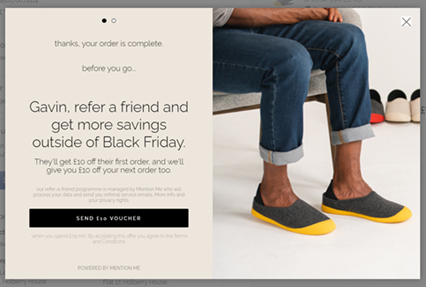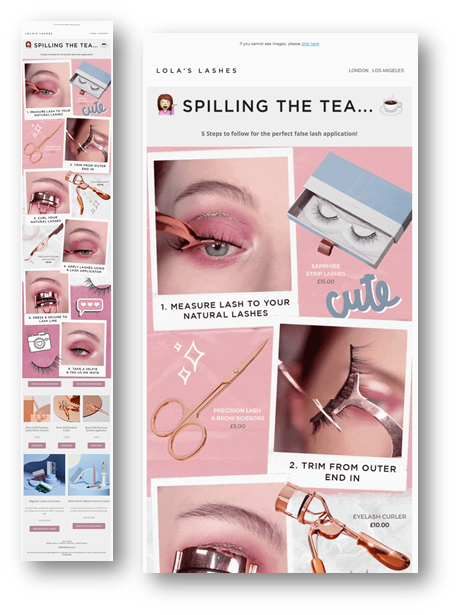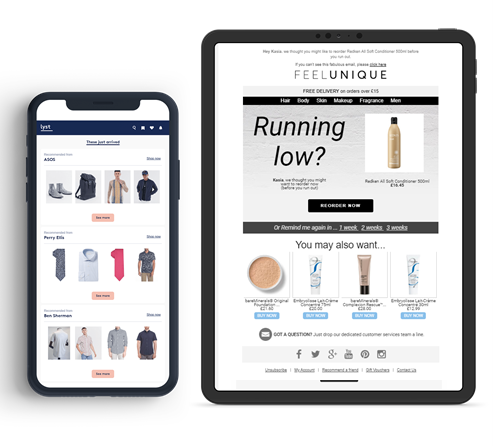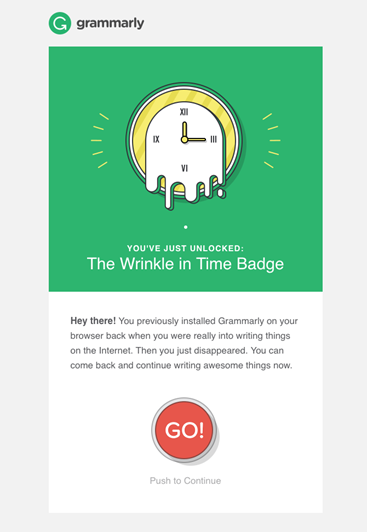Creating credible customer experience
I think it's about time we have a serious conversation. Yes, you reading this. We need to address something before we go any further. I'm going to say something that might be a little controversial. I'm going to give you my secret to achieving digital marketing greatness.
Ready?
Stop paying so much attention to your open rates, clicks and conversions! OK, maybe I went a little too dramatic. Of course, you need to pay attention to metrics, especially conversions (make sure you know how to measure ROI), but don't get too hung up on them. Instead, think about how you can put your customer at the centre of everything you do! Make your comms more relevant!
Simples! Right?! It's just that simple. Thank you, that's it. We're done here. Thank you for reading!
Honestly, the customer experience is vital for any business to grow. I'm constantly going on about data, but you'll have none to work with if you're not focusing on making the customer experience the best that it can be. If you're not taking CX seriously, I can guarantee your competitors will, and they'll be retaining clients better than you will as a result.
According to a report from PWC
“59% of customers will walk away after several bad experiences. And 17% after just one bad experience."
So how can we do something about this? I hear you cry. Well, we need to consider how to make our comms more relevant, and typically that means delivering more targeted and personalized experiences because each of your customers is unique. Luckily email has some nifty tricks up its sleeves to help you provide the customer experience your customers wished they had.
Let's look at the different stages of a typical customer lifecycle. We'll highlight how email can slot in and generate the positive sentiment you need to keep your customers coming back again and again.
The four areas to focus on are:
Acquire, Convert, Retain, Reactivate
So let's get into them!
Acquire
This is probably the most important of the stages. This is where you're looking to collect that all-so-precious data to help enrich the journey each customer will embark on with you.
The goal is simple: get the individual you want to buy your products or service. The stages include a couple of areas. Target, Attract and Capture.
- Target: This is all about creating personas or a buyer profile to understand your prospective customers better.
"82% of companies using personas have created an improved value proposition."
Cintel
- Attract: Attract visitors to your website with great content like ebooks, infographics, research reports, webinars, social media and blog posts.
- Capture: Use a web form that includes the hook from the attract phase to secure the email address and any other data you require. In a B2B setting, you may need more than just the email address, but be careful not to overload with too many questions. You only need to collect what you need. Not what you want. And if you're unsure about the difference between what and need, well, take a second and ask yourself the question honestly. You'll soon find the answer to that.

Here's a strong example of what you're looking for from Mahabis. There's an initial offer, which doesn't always need to offer money off, but they're also letting us know what else may be on the card if we subscribe. And they're only interested in the email address thus far, but they'll most certainly look to collect more down the line. It's by no means the best forum I've seen, but it's uncomplicated, and it does the job. We'll revisit this form a little later.
Convert
Arguably the hard part has been done. You have their email address. Now you need to impress them!
You'll never have a second chance at making an excellent first impression. And you'll never convert without forming some form of relationship. To make this step count! Bring out the big guns and welcome them into your world and get them ready to buy. The convert phase stages are Engage, Offer and Close.
Engage: This is where the welcome email (or welcome program) lives. Introduce yourself; highlight what your business is all about; collect as much information about them as you can via forms and web-capture to help with personalization. But overall, make them feel welcomed and a part of something fun and exclusive.
Offer: Exactly what it says on the tin. Again it doesn't have to be money off or a freebie. You need to make your value prop clear. What's in it for them?
Close: It's more than just making the transaction. Please make sure you communicate everything clearly, make quality assurances and make it easy for them to follow up with questions should they need to.

Now let's revisit that Mahabis form. It was pleasant and straightforward and resulted in a lovely welcome email, with a great hero gif, clear CTA, user-generated content, reviews, and PR. All of which help to engage the contact and draw them in with substantiated content. Throw in a reminder of the offer that they would have received on sign up, and you're practically on your way to a sure sale.

If you can strike while the iron's hot and turn one new customer into several by offering them the opportunity to share their outstanding customer experience with friends and family. It worked on me!
Retain
We need to realize that all customers, after their purchase, are lapsing, and they'll be lapsing until we win them back.
Typically in a B2B world, we want them to upgrade after a while. In which case we remind them of what it is they've bought. Showing them how to get the best out of the product or renew the contract. Typically in a B2C world, the idea is to keep them buying more.
At this stage, it's all about consistency, cadence and your personality.
Consistency: We need to make sure that all subsequent comms are as incredible as the welcome. You've made that first sale, excellent! But it's not over; keep up the good work. Don't become complacent.
Cadence: Don't bombard them! Communicate when you need to on the channels you need to. And get as much feedback as you can to help bolster your relationship by doing more of the things they like and are asking for.
Personality: Let it shine through. Work on that tone of voice. It's your USP!
What you need to do once you've managed to sell your wares is to walk a virtual tightrope line. be helpful, but not pushy. Be present and available, but don't overstay your welcome. To do this, you need not constantly be pushing the sale. This email from Lola's lashes does a pretty good job of keeping a solid standard of design and getting a lot into a relatively small space (using gifs) but also using their personality to get their point across

I have no idea what "spilling the tea" means, but I'm sure Lola's lashes audience does. That tone of voice helps you connect over just the quality of your product and goes a step further to creating fans, not just customers.
What this email also does is give pointers on how to use the products highlighted in the email. This is a tactic B2B marketer can take advantage of, too, to educate users on new and different features based on their usage.
Remember, it's not always about the emails you send. Why not direct customers to your blog, events, infographics even other websites that might tickle their fancy based on what you know about them.
Success breeds success, so lead customers to helpful customer testimonial and encourage them to leave their reviews. If they can see helpful customer testimonials, it'll build trust. The psychology behind this is fascinating. You feel more comfortable trusting the words of someone who has gone through the same experience you have. Also, be sure to reward those who have left glowing reviews for you, and even if they haven't but continue to purchase with you, go out of your way to say thank you. You want to encourage loyalty at every chance you get, so shower them with gifts or at least make them feel special, that could be by remembering their birthday and just saying "Hey!"

Once you've built trust and a bond with your customers, you can go the extra mile and be helpful by recommending products that you have a fair idea that they'll love, just like a trusted friend would do. See, we're building rapport! Using a recommendation engine, you can personalize the content send to each individual to a T. Take these examples from Lyst and Feel Unique; browsing behaviour and previously purchased products guide the way to the next purchase. This could even be based on shoppers that have a very similar browsing behaviour.
Reactivate
At times regardless of our efforts, we just can't connect with some people. We should already be connecting via other channels, live chat or SMS. Facebook can be great too - top tip create a customer audience when building your welcome program. That way, if you ever lose contact, you can always fall back on another means of communication.
Mainly in the B2B sector, we'll look to loop the account management or customer success team into the fold. They'll know the relationship and can help you with pointers. But also, we should have markers in place to help us see that we're losing someone.
Lead scoring & RFM (or eRFM) modelling can be great for this. This will highlight who is at risk and who qualifies for a lapsing program—before they're gone, gone.
Be sure to run lapsing programs to keep tabs on those individuals you're losing touch with, but if those programs aren't successful, we can either let them go and count it as a loss or send a re-engagement email to bring them back.
This email from Grammarly gets straight to the point. You don't have to be that direct, but what else do you have to lose?
Conclusion
If we want to keep hold of our customers, we need to give back as much as we take from them. If we're collecting their data be prepared to use it to make them feel as wanted and desired as they should feel. Mastering this, like anything else in marketing, takes time, effort, and patience. Take things one step at a time, look for inspiration, but above all, reach out for help whenever you need it.

 How to resolve AdBlock issue?
How to resolve AdBlock issue? 

